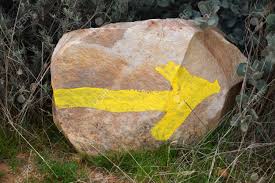One of the most popular symbols of the Camino de Santiago is the famous yellow arrow which indicates the actual route that crosses the villages, open fields, forests and rivers.
In Spain, especially on the Camino francés, the entire route is extremely well marked with yellow arrows. Sometimes these are crudely brushed onto a wall or post, sometimes they are ‘formally’ created signs. They are always encountered at division points or intersections in the road or path.


However the story of where the arrows come from is fascinating as they are closely linked to the popularization of the Camino which we owe to Don Elias Valina Sampedro of O Cebreiro Parish – a dedicated priest and scholar who devoted over 30 years of his life to the resurrection and promotion of the Camino.
D Elias was appointed priest of the Parish of Santa Maria La Real of O Cebreiro in 1959 when he was just 30 years old. Under his direction the Church of St Mary’s as well as the ancient inn and pilgrim hospital which he described as being “little more than a dunghill” – were restored and in 1972 O Cebreiro was declared a Historical Monument.
He concentrated all of his energies on the restoration and reanimation of the Camino. In 1967, he wrote his doctoral thesis on – The Road of St James: A Historical and Legal Study. He directed the ‘Artistic Inventory of Lugo and its Province’, six large volumes of an exhaustive description of all the monuments and items that could have any value.
“In the 1970’s there survived only a remote memory of the Jacobean pilgrimage” he wrote. In 1971 he wrote the book ‘Caminos a Compostela’.
In 1972, only 6 pilgrims were awarded the Compostela.
Elias’s guide was published in 1982 and at a gathering in Santiago in 1985 he was entrusted with the co-ordination of all the resources for the Camino. Pilgrim albergues were established and he was the first to mark the way with yellow arrows. He drove all over the north of Spain in his Citroen GS, with paint scrounged from the roads department, painting arrows leading the way to Santiago.
Ten years later, in 1986, the Santiago Cathedral issued 2,491 certificates. In 1989, the year of the Pope’s visit (and sadly, also the year D Elias passed away) 5,760 compostelas were issued. In the 2010 Holy Year (when St James Day, 25th July, falls on a Sunday) 272,703 Compostelas or Certificates were issued.
Each of the estimated 250,000 pilgrims who trustingly follow the yellow arrows this year, should remember the generous hand that lovingly painted them.




